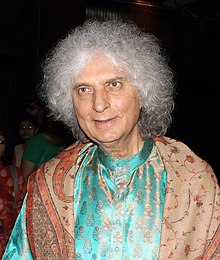Pandit Shivkumar Sharma
| Shivkumar Sharma | |
|---|---|

Pandit Shivkumar Sharma after performance and Talk in First Santoor Samaroh (Santoor Concert) at Bharat Bhavan Bhopal July 2016
|
|
| Background information | |
| Born |
13 January 1938 Jammu, British India (now Jammu and Kashmir, India) |
| Origin | Jammu, India |
| Genres | Hindustani classical music |
| Instruments | santoor |
| Years active | 1955–present |
| Associated acts | Rahul Sharma |
| Website | www.santoor.com |
Pandit Shivkumar Sharma (born 13 January 1938) is an Indian santoor player from the state of Jammu and Kashmir. The santoor is a folk instrument.
He was born in Jammu to the singer Uma Dutt Sharma and his mother tongue is Dogri. His father started teaching him vocals and tabla when he was just five. Uma Dutt Sharma did "extensive research" on the santoor, and decided that Sharma should be the first musician to play Indian classical music on the santoor. So he started learning santoor at the age of thirteen, and made his father's dream come true. He gave his first public performance in Bombay in 1955.
Shivkumar Sharma is the master instrumentalist of the santoor, after some years as a vocalist. He is credited with making the santoor a popular Classical Instrument. In a 1999 interview to rediff.com, Shivkumar said that it was his father who decided that he should play the santoor and that he never thought he would be choosing it when he started learning music. He composed the background music for one of the scenes in Shantaram's Jhanak Jhanak Payal Baje in 1956. He recorded his first solo album in 1960.
In 1967, he teamed up with flautist Hariprasad Chaurasia and Brij Bhushan Kabra to produce a concept album, Call of the Valley (1967) which turned out to be one of the greatest hits in Indian Classical Music. He has composed music for many Hindi films in collaboration with Hariprasad Chaurasia starting with Silsila (1980). They came to be known as the 'Shiv-Hari' music duo. Some of the movies they composed music for that were big musical hits are Faasle (1985), Chandni (1989), Lamhe (1991) and Darr (1993).
...
Wikipedia
